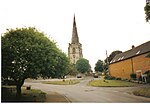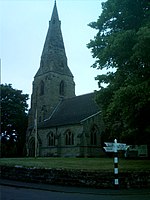Thorpe Constantine
Civil parishes in StaffordshireCountry houses in StaffordshireLichfield DistrictUse British English from July 2016Villages in Staffordshire

Thorpe Constantine is a small village and civil parish in Staffordshire, England. It lies about 6 miles (10 km) north-east of Tamworth and 6 miles south-west of Measham. The nucleus of the parish is the Thorpe estate.
Excerpt from the Wikipedia article Thorpe Constantine (License: CC BY-SA 3.0, Authors, Images).Thorpe Constantine
Thorpe Lane, Lichfield Thorpe Constantine
Geographical coordinates (GPS) Address Nearby Places Show on map
Geographical coordinates (GPS)
| Latitude | Longitude |
|---|---|
| N 52.675 ° | E -1.616667 ° |
Address
Thorpe Lane
Thorpe Lane
B79 0LJ Lichfield, Thorpe Constantine
England, United Kingdom
Open on Google Maps











